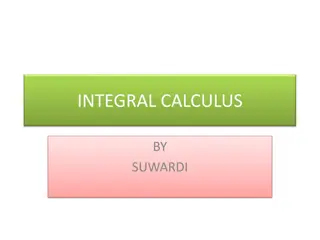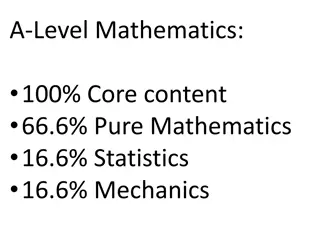Differentiation Concepts in Mathematics
Explore the concept of finding gradients of curves, understanding the patterns, and proving gradients mathematically. Learn notations for expressing gradients and tackle a practice problem to enhance your understanding.
Uploaded on Feb 27, 2025 | 0 Views
Download Presentation

Please find below an Image/Link to download the presentation.
The content on the website is provided AS IS for your information and personal use only. It may not be sold, licensed, or shared on other websites without obtaining consent from the author.If you encounter any issues during the download, it is possible that the publisher has removed the file from their server.
You are allowed to download the files provided on this website for personal or commercial use, subject to the condition that they are used lawfully. All files are the property of their respective owners.
The content on the website is provided AS IS for your information and personal use only. It may not be sold, licensed, or shared on other websites without obtaining consent from the author.
E N D
Presentation Transcript
C1 Chapter 7 Differentiation Dr J Frost (jfrost@tiffin.kingston.sch.uk) Last modified: 13th October 2013
Gradient of a curve The gradient of the curve at a given point can be found by: 1. Drawing the tangent at that point. 2. Finding the gradient of that tangent.
How could we find the gradient? We want to find the gradient at the point A. x represents a small change in x and y represents a small change in y.
How could we find the gradient? Suppose we re finding the gradient of y = x2 at the point A(3, 9). Gradient = 6 ?
How could we find the gradient? For the curve y = x2, we find the gradient for these various points. Can you spot the pattern? Point (1, 1) (4, 16) (2.5, 6.25) (10, 100) Gradient 2 8 5 20 For y = x2, gradient = 2x? Let s prove it...
Proof that gradient of y = x2 is 2x Suppose we add some tiny value, h, to x. Then: The lim bit means what this expression approaches as h tends towards 0 (x + h, (x+h)2) ? ? (x, x2) y x ? The h disappears as h tends towards 0.
Further considerations (This slide is intended for Further Mathematicians only) You may be wondering why we couldn t just set h to be 0 immediately. Why did we have to expand out the brackets and simplify first? If h was 0 at this stage, we d have 0/0. This is known as an indeterminate form (i.e. it has no value!) We don t like indeterminate forms, and want to find some way to remove them. In this particular case, just expanding the numerator resolves the problem. There are 7 indeterminate forms in total: 0/0, 00, inf/inf, inf inf, 1inf, inf^0, and 0 x inf
Notation These are ways in which we can express the gradient. dy dx = 2x y = x2 Leibniz's notation ? f(x) = x2 f (x) = 2x Lagrange s notation ?
Your Turn: What is the gradient of y = x3? (x + h, (x+h)3) ? (x, x3) ? y x ?
Differentiating xn Can you spot the pattern? x2 x3 x4 x5 x6 y 3x2 4x3 5x4 6x5 dy/dx 2x ? If y = xn, then dy/dx = nxn-1 ? If y = axn, then dy/dx = anxn-1 In general, scaling y also scales the gradient y = x7 dy/dx = 7x6 y = x10 dy/dx = 10x9 ? ? y = 2x3 dy/dx = 6x2 f(x) = 2x3 f (x) = 6x2 ? ? f(x) = x2 + 5x4 f (x) = 2x + 20x3y = 3x1/2 dy/dx = 3/2 x-1/2 ? ?
Differentiating cx and c y What is the gradient of the line y = 3x? How could you show it using differentiation? y = 3x = 3x1 Then dy/dx = 3x0 = 3 ? x What is the gradient of the line y = 4? How could you show it using differentiation? y = 4 y = 4 = 4x0 Then dy/dx = 0x-1 = 0 ? x
Differentiating cx and c ?? ??= 3 ? = 3? ? ? ? = 0 ? ? ? = 7 ?? ??= 1 ? ? = ? ?? ??= 0 ? ? = 74
Exercises Be sure to use the correct notation for the gradient. Function Gradient Point(s) of interest Gradient at this point ? ? ? ? ? ? ? ? ? ? ? ? = 2?5 ? ? = 7?3 ? = 2? + ?2 ? ? = ?3+ ? 1+ 3 ? ? = ?4 ? = ?3+ 4 ? =1 3?3+ ?2 dy/dx = 10x4 (2, 64) 160 f (x) = 21x2 (3, 189) 189 dy/dx = 2 + 2x (4, 24) 10 f (x) = 3x2 x-2 (2, 11.5) 11.75 f (x) = 4x3 (2, 16) 32 ? ? dy/dx = 3x2 (3, 31), (-3, -23) 3,0 , 1,4 27 ?? ??= ?2+ 2? ? 3 3
Test your knowledge so far... Edexcel C1 May 2012 ?? ??= 15?2 8? 1 3+ 2 ? ?2? ??2= 30? 8 3? 2 ? 3
Turning more complex expressions into polynomials We know how to differentiate things in the form ???. Where possible, put expressions in this form. 1 2 ? ? ? 1 ?2= ? 2 ? 1 ?= ? 1 ? 2 1 + ? = ? 1 1 2 2+ ? ? ? ?2 ? ?2 ?3 3 2 = ? 5 2 ? 1 ? ? ?= ? ? ?2? 1 = ?3 ?2
Exercise 7E (Page 115) 1 Use standard results to differentiate. ?? ??= ? 1 ?? ??= ? 4 ?? ??= 6? 4+1 ?? ??=1 ?? ??= 3 + 6? 2 ?? ??= 3?2 2? + 2 ?? ??= 24? 8 + 2? 2 ? ? 2 a) y = 2 ? c) y = 1 3?3 2 ?3+ ? 3? + 2? 1 2? 2 ? ? ? ? ? e) y = 2 3 1 1 3? 2 f) y = h) y =3?2 6 j) y = ? ?2 ? + 2 y = 3? 2 2? ? 4? +1 l) ? Find the gradient of the curve with equation ? = ?(?) at the point A where: 2 1 1 4,2 ? ? c) ? ? = ? and A is at 4 ?2 and A is at 2,5 4 4 d) ? ? = 3?
Finding equations of tangents Find the equation of the tangent to the curve ? = ?2 when ? = 3. Function of gradient: ?? ??= ?? ? ? Gradient when ? = 3: ? = ? ? ?-value when ? = 3: ? = ? ? = 3 So equation of tangent: ? ? = ? ? ? ?
Finding equations of tangents Find the equation of the normal to the curve ? = ?2 when ? = 3. Function of gradient: ?? ??= ?? Gradient when ? = 3: ? = ? Perpendicular gradient when ? = 3: ? = ? ? ? ? = 3 ?-value when ? = 3: ? = ? So equation of normal: ? ? = ? ? ?? ?
Second Derivative We can differentiate multiple times. For C1, you needn t understand why we might want to do so. Name Leibniz Notation Lagrange Notation ? ? ? ? ? (Original expression/function) ?? ?? ?2? ??2 ??? d?? First Derivative ? ? Second Derivative ??? ?th Derivative ?2? ??2= 30? ? = 5?3 ? ?2? ??2= 30? ? ? =
(questions on worksheet) Equations of tangents and normals Edexcel C1 Jan 2013 ?? ??= 2 4? 1 ? 2 ? = 6? + 3 ? ? (9, -1) Recap: If a line has gradient m and goes through ?1,?1, then it has equation: ? ?1= ? ? ?1
Equations of tangents and normals Edexcel C1 Jan 2012 1 2,0 ? 8,17 ? 8
Equations of tangents and normals Expanding gives ? = ?3+ 7?2+ 15? + 9 Thus ?? ?? is as given. ? ? = 3 52+ 14 5 + 15 = 20 So ? + 16 = 20 ? + 5 ?1= 5 + 1 5 + 32= 16 ? = 20? + 84 ? We re interested where the gradient is 20. 3?2+ 14? + 15 = 20 3?2+ 14? 5 = 0 3? 1 ? + 5 = 0 So ? = 5 (as before) or ? =1 ? 3
Equations of tangents and normals Edexcel C1 Jan 2011 ?? ??=3 2?2 27 1 2 8? 2 2? ? 1 243 9 4 = 32 72 + 2 + 30 = 8 ? 3 2+8 4+ 30 ?????=3 242 27 4 8 42= 24 27 1 2= 9 2 2 Thus ? =2 9 9? 4 ? ? + 8 =2 9? + 8 = 2? 8 2? 9? 16 = 0























